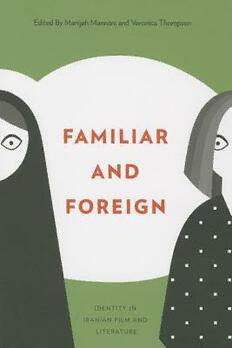
Familiar and Foreign: Identity in Iranian Film and Literature PDF
Preview Familiar and Foreign: Identity in Iranian Film and Literature
FAMILIAR AND FOREIGN FAMILIAR AND FOREIGN IDENTITY IN IRANIAN FILM AND LITERATURE Edited by Manijeh Mannani and Veronica Thompson Copyright © 2015 Manijeh Mannani and Veronica Thompson Published by AU Press, Athabasca University 1200, 10011 – 109 Street, Edmonton, AB T5J 3S8 ISBN 978-1-927356-86-9 (print) 978-1-927356-87-6 (PDF) 978-1-927356-88-3 (epub) doi: 10.15215/aupress/9781927356869.01 Cover design by Marvin Harder, marvinharder.com. Interior design by Sergiy Kozakov. Printed and bound in Canada by Friesens. Library and Archives Canada Cataloguing in Publication Familiar and foreign : identity in Iranian film and literature / edited by Manijeh Mannani and Veronica Thompson. Includes bibliographical references. Issued in print and electronic formats. 1. Persian literature—History and criticism. 2. Motion pictures—Iran—History. 3. National characteristics, Iranian, in literature. 4. National characteristics, Iranian, in motion pictures. 5. Persian literature—Western influences. 6. Motion pictures—Iran—Western influences. I. Thompson, Veronica, 1963-, editor II. Mannani, Manijeh, 1964-, editor PK6412 I34 F34 2015 891'.5509 C2015-904428-6 C2015-904429-4 We acknowledge the financial support of the Government of Canada through the Canada Book Fund (CFB) for our publishing activities. Assistance provided by the Government of Alberta, Alberta Multimedia Development Fund. Please contact AU Press, Athabasca University at [email protected] for permissions and copyright information. The illustrations in chapter 4 are from Persepolis: The Story of a Childhood, by Marjane Satrapi, translation copyright © 2003 by L’Association, Paris, France, and from Persepolis 2: The Story of a Return, by Marjane Satrapi, translation copyright © 2004 by Anjali Singh. Used by permission of Pantheon Books, an imprint of the Knopf Doubleday Publishing Group, a division of Random House, LLC. All rights reserved. Chapter 3, “Autobiomythography and Self-Aggrandizement in Iranian Diasporic Life-Writing: Fatemeh Keshavarz and Azar Nafisi,” by Manijeh Mannani, is a revised version of an essay that originally appeared under the title “Reading Beyond Jasmine and Stars: Reading More Than Lolita in Tehran,” in Comparative Studies of South Asia, Africa, and the Middle East 29.2 (2009): 322–34. Copyright 2009, Duke University Press. All rights reserved. Reprinted by permission of the publisher. Chapter 10, “Film as Alternative History: The Aesthetics of Bahram Beizai,” by Khatereh Sheibani, is a revised version of “Mirroring the Past, Envisioning the Future,” chapter 5 in Khatereh Sheibani, The Poetics of Iranian Cinema: Aesthetics, Modernity and Film After the Revolution (London: I. B. Tauris, 2011). Reprinted by permission of the publisher. Contents Familiar and Foreign: An Introduction • Manijeh Mannani and Veronica Thompson 3 1 The Development of the Artistic Female Self in the Poetry of Forugh Farrokhzad • Safaneh Mohaghegh Neyshabouri 17 2 Overcoming Gender: The Impact of the Persian Language on Iranian Women’s Confessional Literature • Farideh Dayanim Goldin 31 3 Autobiomythography and Self-Aggrandizement in Iranian Diasporic Life- Writing: Fatemeh Keshavarz and Azar Nafisi • Manijeh Mannani 61 4 Graphic Memories: Dialogues with Self and Other in Marjane Satrapi’s Persepolis and Persepolis 2 • Mostafa Abedinifard 83 5 Mr. and Mrs. F and the Woman: Personal Identities in Zoya Pirzad’s Like All the Afternoons • Madeleine Voegeli 111 6 Anxious Men: Sexuality and Systems of Disavowal in Contemporary Iranian Literature • Blake Atwood 129 7 Reading the Exile’s Body: Deafness and Diaspora in Kader Abdolah’s My Father’s Notebook • Babak Elahi 149 8 Persian Literature of Exile in France: Goli Taraqqi’s Short Stories • Laetitia Nanquette 173 9 Farang Represented: The Construction of Self-Space in Goli Taraqqi’s Fiction • Goulia Ghardashkhani 189 10 Film as Alternative History: The Aesthetics of Bahram Beizai • Khatereh Sheibani 211 11 Technologies of Memory, Identity, and Oblivion in Persepolis (2007) and Waltz with Bashir (2008) • William Anselmi and Sheena Wilson 233 Contributors 261 Remember the flight The bird is mortal Forugh Farrokhzad Familiar and Foreign An Introduction Manijeh Mannani and Veronica Thompson A t a time when the Iranian government figures prominently in mainstream media for its foreign policy and nuclear program and when a diversity of voices and perspectives is lacking in the West, it seems pertinent to engage with artistic and literary works that offer more nuanced depictions of Iranian society than are generally available. In the face of predominantly simplistic and monolithic representations of Iran as a repressive, profoundly patriarchal, and politically intractable nation full of religious fanatics imbued with a hatred of the West and prone to terrorism, Iranian artists reveal a very different society, one whose cultural traditions are rooted in a lengthy and complex history that some- times sit uneasily with the demands of modernity. The artists under considera- tion in this volume engage with Iranian culture and Western responses to Iran in two ways: their works question the strategies—and in some cases, the ideol- ogy—that have been imposed internally on Iranian society, and they challenge the new Orientalist discourse that defines the character of Western conceptions. The essentialist approach of Western media, governments, and even financial institu- tions that underlies their responses to an Islamic government demonizes Iranians in Iran who have no say in the dealings of the government, as well as Iranians in diaspora with no ties to or interest in political matters. The artists represented in this collection tackle a range of issues in response to internal and external constructions of Iranian identity, or hoviyyat.1 The question of identity is at the heart of Persian literature and was central to classical Persian poetry, which is essentially spiritual in nature. In the poems of Attar, Jami, Rumi, 3
